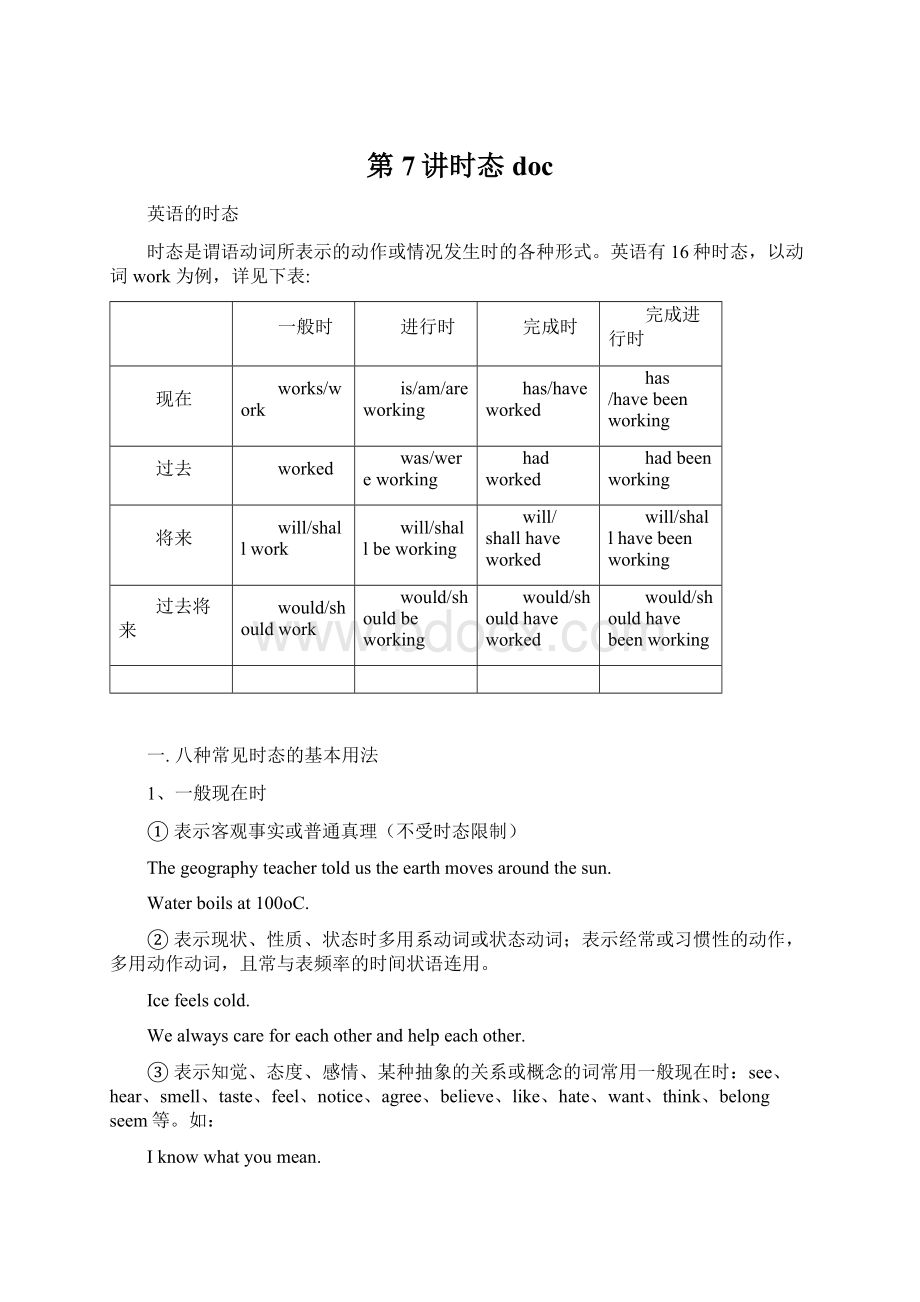第7讲时态doc.docx
《第7讲时态doc.docx》由会员分享,可在线阅读,更多相关《第7讲时态doc.docx(30页珍藏版)》请在冰豆网上搜索。

第7讲时态doc
英语的时态
时态是谓语动词所表示的动作或情况发生时的各种形式。
英语有16种时态,以动词work为例,详见下表:
一般时
进行时
完成时
完成进行时
现在
works/work
is/am/areworking
has/haveworked
has/havebeenworking
过去
worked
was/wereworking
hadworked
hadbeenworking
将来
will/shallwork
will/shallbeworking
will/shallhaveworked
will/shallhavebeenworking
过去将来
would/shouldwork
would/shouldbeworking
would/shouldhaveworked
would/shouldhavebeenworking
一.八种常见时态的基本用法
1、一般现在时
①表示客观事实或普通真理(不受时态限制)
Thegeographyteachertoldustheearthmovesaroundthesun.
Waterboilsat100oC.
②表示现状、性质、状态时多用系动词或状态动词;表示经常或习惯性的动作,多用动作动词,且常与表频率的时间状语连用。
Icefeelscold.
Wealwayscareforeachotherandhelpeachother.
③表示知觉、态度、感情、某种抽象的关系或概念的词常用一般现在时:
see、hear、smell、taste、feel、notice、agree、believe、like、hate、want、think、belongseem等。
如:
Iknowwhatyoumean.
Smithownsacarandahouse.
AllthestudentsherebelongtoNo.1MiddleSchool.
④在时间、条件状语从句中常用一般现在时代替将来时。
但要注意由if引导的条件状语从句中可以用shall或will表“意愿”,但不表示时态。
Ifyouwillacceptmyinvitationandcometoourparty,myfamilywillbepleased.
如果你愿意接受并参加我们的舞会,我的家人会非常高兴。
⑤少数用于表示起止的动词如come、go、leave、arrive、fly、return、start、begin、pen、close、end、stop等常用一般现在时代替将来时,表示一个按规定、计划或安排要发生的动作。
当be表示根据时间或事先安排,肯定会出现的状态,只用一般现在时。
Theshopclosesat11:
00p.m.everyday.
TomorrowisWednesday.
2、一般过去时
①一般过去时的基本用法:
表示过去的事情、动作或状态常与表示过去具体的时间状语连用(或有上下文语境暗示);用于表达过去的习惯;表示说话人原来没有料到、想到或希望的事通常用过去式。
如:
Imetherinthestreetyesterday.
Ioncesawthefamousstarhere.
Theyneverdrankwine.
Ithoughtthefilmwouldbeinteresting,butitisn’t.
②如果从句中有一个过去的时间状语,尽管从句中的动作先于主句发生,但从句中的谓语动词连用过去式。
如:
Hetoldmehereadaninterestingnovellastnight.
③表示两个紧接着发生的动作,常由以下词语连接,用一般过去时。
如:
but,and,when,assoonas,immediately,themoment,theminute。
Themomentshecamein,shetoldmewhathadhappenedtoher.
Heboughtawatchbutlostit.
④常用一般过去时的句型:
Whydidn’tyou/Ithinkofthat?
Ididn’tnoticeit.
IforgottotellyouIhadbeentherewithmybrotherbefore.
Ididn’trecognizehim.
3、一般将来时
①表示未来的动作或状态常用will/shall+动词(常与表示将来的时间状语边用如tomorrow、nextweek等)。
②表示一种趋向或习惯动作。
We’lldiewithoutairorwater.
③表示趋向行为的动词如come、go、start、begin、leave等词常用进行时的形式表示将来时。
④begoingto与will/shall,betodo,beabouttodo用法及区别:
a.begoingto表示现在打算在最近或将来要做某事,这种打算往往经过事先考虑,甚至已做了某种准备;shall/willdo表示未事先考虑过,即说话时临时作出的决定。
b.begoingto表将来,不能用在条件状语从句的主句中;而will则能,表意愿。
如:
Ifitisfine,we’llgofishing.(正确)
Ifitisfine,wearegoingtogofishing.(错误)
c.betodosth.表按计划、安排即将发生的动作,还可表示吩咐、命令、禁止,可能性等。
Ameetingistobeheldat3:
00o’clockthisafternoon.
d.beabouttodosth.表示“即可,就要”,后面不能接时间状语或状语从句。
Autumnharvestisabouttostart.
4、现在进行时
①表示说话时正在发生着的一个动作;表示现阶段但不一定是发生在讲话时;表近期特定的安排或计划;go、come等起止动作可用进行时代替将来时。
如:
Itisrainingnow.
HeisteachingEnglishandlearningChinese.
IammeetingMr.Wangtonight.
WeareleavingonFriday.
AtsixIambathingthebaby.(Istartbathingthebadybeforesix.)
Thegirlisalwaystalkingloudinpublic.
(与always、often等频度副词连用,表经常反复的行动或某种感情色彩)
②下面四类动词不宜用现在进行时。
(A)表示心理状态、情感的动作:
like,love,hate,care,remember,believe,want,mind,wish,agree,mean,need。
(B)表存在的状态的动词:
appear,exist,lie,remain,seembelongto,dependon。
(C)表示一时性动作的动词:
allow,accept,permit,promise,admit,complete。
(D)表示感官的动词:
see,hear,notice,feel,smell,sound,taste,look。
5、过去完成时
①常用过去完成时的几种情况:
(A)在by、bytheend、bythetime、until、before、since后接表示过去某一时间的短语或从句以前发生的动作。
如:
Bytheendoflastyear,wehadproduced20,000cars.Thetrainhadleftbeforewereachedthestation.
(B)表示曾实现的希望、打算、意图、诺言等。
常用hadhoped/planned/meant/intended/
though/wanted/expected等或用上述动词过去式接不定式完成式表示即:
hoped/planned…+tohavedone。
(C)“时间名词+before”在句子中作状语,谓语动词用过去完成时;“时间名词+ago”在句中作状语,谓语动词用一般过去式。
如:
Hesaidhisfirstteacherhaddiedatleast10yearsbefore.XiaoHualeftschool3yearsago.
(D)表示“一……就”的几个句型:
Hardly/Nosooner/Scarcelyhad+主语+过去分词+when/than/before+一般过去时。
如:
Wehadnosoonerbeenseatedthanthebusstarted.=Nosoonerhadwebeenseatedthanthebusstarted.
②在before或after引导的时间状语从句中用一般过去时态代替过去完成时。
Afterhe(had)lefttheroom,thebosscamein.
Wearrivedhomebeforeitsnowed.
6、过去将来时
参照一般将来时对比:
用woulddo、was/weregoingtodosth.表过去将来;come、go、leave等过去进行时表过去将来时;was/weretodosth.和was/wereabouttodosth.表过去将来。
7、过去进行时考点分析。
①过去某一时刻正在进行的动作或某一阶段内发生或频繁发生。
②某一动作发生时另一动作正在发生,其中一个在由when或while引导的时间状语从句中。
8、现在完成时
①现在完成时除可以和for、since引导的状语连用外,还可以和下面的介词短语连用:
during/in/overthelast(past)fewyears(months,weeks)、inrecentyears等。
②下列句型中常用现在完成时
Itis(hasbeen)+一段时间+since从句
This(That/It)isthefirst(second…)timethat+完成时
This(That/It)istheonly…+that+完成时
This(that/It)isthebest/finest/mostinteresting…+that从句+完成时
③在时间或条件状语从句中,现在完成时可以代替一般将来时。
如:
IshallposttheletterassoonasIhavewrittenit.
Ifyouhavedonetheexperiment,youwillrealizethetheorybetter.
Don’tgetoffthebusuntilithasstopped.
二.时态常见考点汇总
1、一般现在时
主要用来表示人、事物的现在状况和特点;表示经常或习惯性的动作,句子中常有often,always,fromtimetotime等时间状语;表示客观规律和永恒真理等。
Heusuallygoestoworkat7o’clockeverymorning.
ShehasabrotherwholivesinNewYork.
Theearthgoesaroundthesun.
GuangzhouissituatedinthesouthofChina.
考点一:
表示永恒的真理,即使出现在过去的语境中,仍用一般现在时。
如:
IlearnedthattheearthgoesaroundthesunwhenIwasinprimaryschool.
考点二:
在时间和条件状语从句中,代替一般将来时。
常用的引导词有:
时间:
when,until,after,before,assoonas,once,themoment/theminute,theday;
条件:
if,unless,provided.
Ifheacceptsthejob,hewillgetmoremoneysoon.
考点三:
在makesure(certain),seetoit,mind,care,matter+宾语从句,从句用一般现在时代替一般将来时。
Solongasheworkshard,Idon’tmindwhenhefinishestheexperiment.
只要他努力工作,我不介意他什么时候做完实验。
考点四:
在themore…themore…(越……越……)句型中,若主句是一般将来时,从句通常用一般现在时。
Theharderyoustudy,thebetterresultsyouwillget.
2、现在进行时
表说话时或目前一段时间内正在进行的活动;或表感情色彩,加强语气。
与频率副词,如always,constantly,continually,again等连用表示说话人的某种感情色彩(赞叹、厌烦、埋怨等)。
WearehavingEnglishclassnow.
Thehouseisbeingbuiltthesedays.
Thelittleboyisalwaysmakingtrouble.
考点一:
在时间状语从句或条件状语从句中表示将来正在进行的动作。
Lookoutwhenyouarecrossingthestreet.
Don’twakehimupifheisstillsleepingat7tomorrowmorning.
考点二:
表示在最近按计划或安排要进行的动作(这时多有表示将来的时间状语)。
MarryisleavingonFriday.
Wearemeetinghimaftertheperformance.(meet)
3、现在完成时
表示动作发生在过去,完成在过去,但强调与现在情况仍有联系,其结果或影响仍存在。
现在完成时有一些标志性的时间状语:
考点一:
for+时间段;since+时间点/过去式从句
TheyhavelivedinBeijingforfiveyears.
TheyhavelivedinBeijingsince1995.
Itis/hasbeenthreeyearssincesheenteredthisschool.
IhavelearnedEnglishfortenyears.
考点二:
常见的不确定的时间状语:
lately,recently,just,already,yet,uptonow,tillnow,sofar,thesedays,inthepast/lastyears…
Hasitstoppedrainingyet?
考点三:
在表示“最近几世纪/年/月以来……”时间状语中,谓语动词用现在完成时。
inthepastfewyears/months/weeks/days;overthepastfewyears;duringthelastthreemonths;forthelastfewcenturies,jthroughcenturies;throughouthistory等
考点四:
表示“第几次做某事,”或在“itisthebest(worst,mostinteresting)+名词+that”后面跟现在完成时。
ThisismufirsttimethatIhavevisitedChina.
ThisisthemostinterestingfilmIhaveeverseen.
ThiswasthemostinterestingfilmIhadeverseen.
Thatistheonlybookthathehaswritten.
Thatwastheonlybookthathehadwritten.
4、一般过去时
表示在过去某个特定时间发生且完成的动作,或过去习惯性动作,不强调对现在的影响,只说明过去。
常跟明确的过去时间连用,如:
yesterday,lastweek,in1945,atthattime,once,duringthewar,before,afewdaysago,when,注意:
考点一:
usedto+do,表示过去经常但现在已不再维持的习惯动作。
To为不定式,后接动词原形。
be/become/getusedto+doing,表示习惯于
heusedtosmokealot.
Hehasgotusedtogettingupearly.
考点二:
在时间和条件状语从句中,代替过去将来时。
Hepromisedtobuymeacomputerifhegotaraise.
5、过去进行时
表示过去某个时间点或某段时间内正在发生的动作。
Theboywasdoinghishomeworkwhenhisfathercamebackfromwork.
Hewastakingawalkleisurelybythelakewhenheheardsomeoneshoutedforhelp.
Whatwereyoudoingatninelastnight?
Theradiowasbeingrepairedwhenyoucalledme.
6、过去完成时
表示过去某个时间之前已经完成的动作,即过去完成时的动作发生在“过去的过去’,句中有明显的参照动作或时间状语,这种时态从来不孤立使用(before,after,by,uptill).
Therehadbeen25parksinourcityuptill2000.
Bytheendoflasttermwehadfinishedthebook.
Theyfinishedearlierthanwehadexpected.
考点一:
用于hardly/scarcely/barely…when;nosooner…than句型中,主句用过去完成时,从句用一般过去时。
Ihadhardlyfinishedmyworkwhenhecametoseeme.
Ihadnosoonergotintotheroomthanitbegantosnow.
NosoonerhadIarrivedhomethanthetelephonerang.(注意倒装)
考点二:
表示“第几次做某事”,主句用过去时,从句用过去完成时。
Thatwasthesecondtimethatshehadseenhergrandfather.
Itwas3yearssincewehadparted.
考点三:
动词hope,expect,think,intend,mean,want,suppose,plan用过去完成时,表示未实现的愿望、打算和意图。
IhadhopedthatIcoulddothejob.
IhadintendedtoseeyoubutIwastoobusy.=Iintendedtohaveseenyou…
7、一般将来时
表示在将来某个时间发生的动作或情况。
常和tomorrow,nextyear,in2008等表示将来的时间状语连用,其表现形式多达5种。
Beijingwillhostthe29thOlympicgamesin2008.
考点一:
一般将来时总是用在一些时间状语从句或条件状语从句的主句中。
Wewillbeginourclassassoonastheteachercomes.(主句用一般将来时,从句中一定要用一般现在时替代一般将来时)
考点二:
某些(表示短暂性动作的动词)移位动词如arrive,come,go,leave,sail,return,fall,start,begin等,用现在进行时形式表示将来。
IamleavingforBeijingtomorrow.
考点三:
“祈使句+and/or+句子”,这种结构中and后面的句子谓语用一般将来时。
Useyourheadandyouwillfindaway.
考点四:
“am(is,are)goingto+动词原形”,表示打算要做的事或可能要发生的事或有迹象表明。
“am(is,are)aboutto+动词原形”表示按照预定计划或计划准备着手进行的动作,不带有主管打算;后面不跟任何时间状语:
…when…
“am(is,are)to+动词原形”表示必须,必然或计划将要做的事,相当于should或表命令。
TheyaretobemarriedinthisMay.
8、将来进行时
表示将来某个时间正在发生的动作,或按计划一定会发生的事情。
I’llbedoingmyhomeworkthistimetomorrow.明天这会儿我正在写作业。
Thepresidentwillbemeetingtheforeigndelegationattheairport.
9、将来完成时
表示在将来某时刻之前已完成的事情,时间状语非常明显。
考点一:
常用的时间状语一般用by+将来的时间。
如:
bytheendofthisyear,by8o’clockthisevening,byMarchnextyear以及由bythetime…,before或when等引导的副词从句。
Bytheendofnextmonth,hewillhavetraveled1,000milesonfoot.
Bythetimeyourea